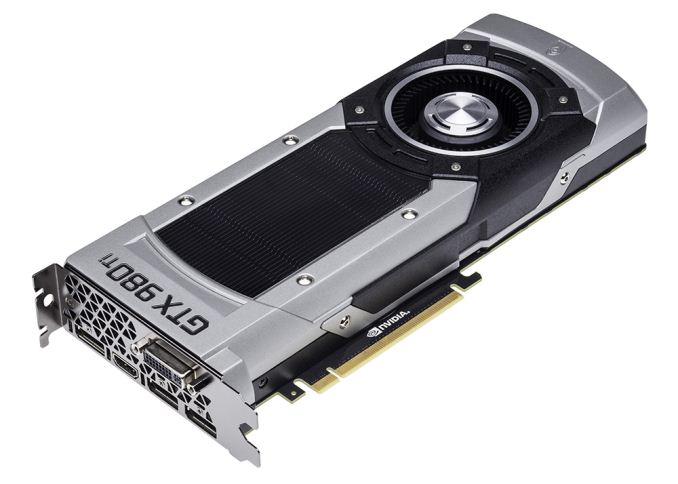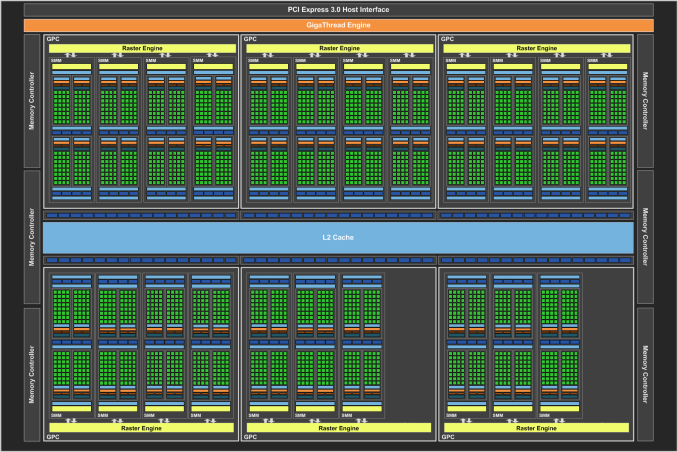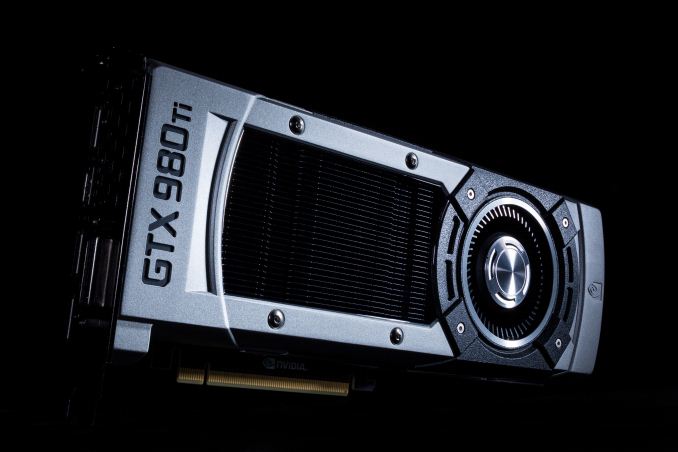The NVIDIA GeForce GTX 980 Ti Review
by Ryan Smith on May 31, 2015 6:00 PM EST
For much of the last year now, the story of the high-end video card market has been the story of NVIDIA. In September of 2014 the company launched the GeForce GTX 980, the first and at the time most powerful member of their Maxwell 2 architecture, setting a new mark for both power efficiency and performance, securing their lead of high-end of the video card market. NVIDIA then followed that up in March with the launch of the GeForce GTX Titan X, NVIDIA’s true flagship Maxwell part, and a part that only served to further cement their lead.
Based on the very powerful (and very large) GM200 GPU, GTX Titan X is currently untouched in performance. However priced at $1000, it is also currently untouched in price. In NVIDIA’s current lineup there is a rather sizable gap between the $550 GTX 980 and $1000 GTX Titan X, and perhaps more significantly GTX Titan X was the only GM200 part on the market. With NVIDIA launching their fully enabled flagship card first, it was only a matter of time until they released a cheaper card based on a cut-down version of the GM200 GPU in order to fill that pricing hole and to put salvaged GM200s to good use.
Now just a bit over two months since the launch of the GTX Titan X, NVIDIA launching their second GM200 card, GeForce GTX 980 Ti. Based on the aforementioned cut-down version of GM200, GTX 980 Ti is the expected junior version of GTX Titan X, delivering GM200 at a cheaper price point. But calling GTX 980 Ti a cheaper GM200 may be selling it short; “cheaper” implies that GTX 980 Ti is a much lesser card. At $649, GTX 980 Ti is definitely cheaper, but the card that is launching today is not to be underestimated. GTX 980 Ti may be intended to be GTX Titan X’s junior, but with the excellent performance it delivers, GTX 980 Ti may as well be GTX Titan X itself.
| NVIDIA GeForce Specification Comparison | ||||||
| GTX Titan X | GTX 980 Ti | GTX 980 | GTX 780 Ti | |||
| CUDA Cores | 3072 | 2816 | 2048 | 2880 | ||
| Texture Units | 192 | 176 | 128 | 240 | ||
| ROPs | 96 | 96 | 64 | 48 | ||
| Core Clock | 1000MHz | 1000MHz | 1126MHz | 875MHz | ||
| Boost Clock | 1075MHz | 1075MHz | 1216MHz | 928Mhz | ||
| Memory Clock | 7GHz GDDR5 | 7GHz GDDR5 | 7GHz GDDR5 | 7GHz GDDR5 | ||
| Memory Bus Width | 384-bit | 384-bit | 256-bit | 384-bit | ||
| VRAM | 12GB | 6GB | 4GB | 3GB | ||
| FP64 | 1/32 FP32 | 1/32 FP32 | 1/32 FP32 | 1/24 FP32 | ||
| TDP | 250W | 250W | 165W | 250W | ||
| GPU | GM200 | GM200 | GM204 | GK110B | ||
| Architecture | Maxwell 2 | Maxwell 2 | Maxwell 2 | Kepler | ||
| Transistor Count | 8B | 8B | 5.2B | 7.1B | ||
| Manufacturing Process | TSMC 28nm | TSMC 28nm | TSMC 28nm | TSMC 28nm | ||
| Launch Date | 03/17/2015 | 06/01/2015 | 09/18/2014 | 11/07/2013 | ||
| Launch Price | $999 | $649 | $549 | $699 | ||
Taking a look at GTX 980 Ti from a specifications perspective, NVIDIA’s latest card is in a somewhat unusual place. Its direct predecessor, GTX 780 Ti, was a fully enabled GK110 card, differing from that generation’s Titan only in double precision compute capabilities and a trivial clockspeed difference. However with GM200 being a pure graphics chip – and hence GTX Titan X not pulling double-duty as a prosumer level compute card – NVIDIA has needed to turn to cutting down the chip itself in order to differentiate the products. In this sense the GTX 980 Ti is probably closer to being the GTX 780 of its generation, a very timely situation given the fact that GTX 780 launched almost exactly 2 years ago.
In any case, compared to GTX Titan X NVIDIA has made just two changes to create GTX 980 Ti. The first is that the company has disabled 2 of GM200’s 24 SMMs, bringing it down to 22 SMMs for a total of 2816 active CUDA cores. The second change was to dial back the amount of VRAM, from GTX Titan X’s 12GB to the 6GB we see on GTX 980 Ti. And that’s it.
In every other aspect the GTX 980 Ti is identical to the GTX Titan X. Both are clocked at 1000MHz, with a boost clock of 1075MHz. Both feature their VRAM on a 384-bit memory bus with their respective VRAM modules clocked at 7GHz. Both are set for a 250W TDP, and are equipped with NVIDIA’s high end metal-shrouded cooler. And finally, GTX 980 Ti retains all 96 ROPs and 3MB of L2 cache, which means that in pixel-heavy situations like 4K it is as no disadvantage compared to GTX Titan X.
Consequently, looking at the specifications tells us that we should expect GTX 980 Ti to be 8% slower than GTX Titan X, a result of losing 2 SMMs. Coupled with the difference in VRAM between the two cards, this would put a decent gap between the two cards. However as we’ll see in our benchmarks, reality begs to differ. Thanks to the combination of a couple of factors GTX 980 Ti ends up coming much closer to GTX Titan X than what the specifications tell us to expect. In the end what we find is that it delivers 97% of GTX Titan X’s performance. This, in a nutshell, is what makes GTX 980 Ti a deceptive card, and is why it’s going to have such a large impact on the high-end market.
Shifting gears, let’s talk about pricing, availability, and the competition. The GTX 980 Ti will be a hard launch, with cards going on sale on June 1st. Due to the fact that Computex is taking place this week in Taiwan and GTX 980 Ti is one of the products NVIDIA is launching at the show, NVIDIA has lifted the embargo on GTX 980 Ti at an atypical 6pm Eastern, which for Taiwan and Computex is June 1st, 6am local time. NVIDIA is launching the card globally on the 1st, so in a reversal of typical launches APAC buyers will get first dibs on the card, followed by European and North/South American buyers several hours later. Along with the GTX 980 Ti reference cards launching today, expect to see semi-custom cards launching very soon thereafter.
Meanwhile for pricing, the GTX 980 Ti will be launching at $649. This is an increasingly persistent price point for NVIDIA that has fluctuated a bit over the last couple of years, with the GTX 780 launching at $649 as well, only for the GTX 780 Ti to launch at $699. The launch of GTX 980 Ti at $649 will be putting pressure on the rest of NVIDIA’s product stack from both above and below. In response to this launch NVIDIA is officially cutting the price of the GTX 980 from $549 to $499 in order to open up a bit more room between the cards and to keep GTX 980 Ti from making GTX 980 redundant. At the same time however GTX 980 Ti puts enormous pressure on GTX Titan X; GTX 980 Ti’s performance is close enough to GTX Titan X that the latter’s only practical advantage is its 12GB of VRAM, and that’s not a lot to justify the Titan’s $350 (54%) price premium.
Not stopping there, in an unusual move for NVIDIA the GTX 980 Ti is getting a game bundle right off the bat. The card isn’t getting NVIDIA’s full Two Times The Adventure bundle that comes with the GTX 980, but it is getting a copy of the forthcoming Batman: Arkham Knight, another one of this year’s major GameWorks titles. The end result is that NVIDIA is being more aggressive than usual this time around, offering what amounts to a GTX Titan X and a game for $649.
Of course the competition may have something to do with it. AMD is pretty much shouting from the rooftops that they are launching a new high-end video card this quarter, which at this point means the card is due by the end of June. While NVIDIA does have other financial incentives for releasing GTX 980 Ti now that GTX Titan X has been on the market for a couple of months, by all appearances this looks to be NVIDIA making the first move. We’ll have to see just what AMD delivers next month, but what is clear is that whatever they do, NVIDIA will not be making it easy by delivering flagship performance at $649.
In the meantime AMD and their partners are also still selling the Radeon R9 295X2 for around $600, though it looks like this is part of an effort to sell off the remaining inventory of cards. AMD has no other cards in this price range, so the GTX 980 Ti is otherwise uncontested until AMD’s new card launches.
| Summer 2015 GPU Pricing Comparison | |||||
| AMD | Price | NVIDIA | |||
| $999 | GeForce GTX Titan X | ||||
| $649 | GeForce GTX 980 Ti | ||||
| Radeon R9 295X2 | $599 | ||||
| $499 | GeForce GTX 980 | ||||
| Radeon R9 290X | $319 | GeForce GTX 970 | |||
| Radeon R9 290 | $250 | ||||












290 Comments
View All Comments
RaistlinZ - Sunday, May 31, 2015 - link
What more would a review of the 960 tell you that you don't already know, honestly? I'd rather read reviews about interesting products like the 980Ti. People need to let the 960 review go already, geez.Michael Bay - Sunday, May 31, 2015 - link
I only trust AT numbers and am in no hurry to upgrade.God I wish they would compare Baytrail/Cherrytrail to i3s.
Brett Howse - Sunday, May 31, 2015 - link
I did compare Cherry Trail to the i3 SP3 in the Surface 3 review. Was there more you were looking for?Michael Bay - Monday, June 1, 2015 - link
I`m trying to get a cheap small notebook for my father. He is currently on i3-380UM and the choice is between N3558 and i3-4030U. Workload is strictly internet browsing/ms office.Not much point in changing anything if performance is going to be worse than it was...
sandy105 - Monday, June 1, 2015 - link
Exactly , it would be interesting to see how much faster than baytrail they are ?DanNeely - Sunday, May 31, 2015 - link
DVI may be an obsolescent standard at this point; but 4/5k gaming is still expensive enough that a lot of the people buying into it now are ones who're upgrading from older 2560x1600 displays that don't do DP/HDMI 2. A lot of those people will probably keep using their old monitor as a secondary display after getting a new higher resolution one (I know I plan to); and good DL-DVI to display port adapters are still relatively expensive at ~$70. (There're cheaper ones; but they've all got lots of bad reviews from people who found they weren't operating reliably and were generating display artifacts: messed up scan lines.) Unless it dies first, I'd like to be able to keep using my existing NEC 3090 for a few more years without having to spend money on an expensive dongle.YazX_ - Sunday, May 31, 2015 - link
Dude, majority are still playing on 1920x1080 and just few now are making the leap to 2560x1440p, i have been gaming on 1440p since two years and not planning to go 4k anytime soon since hardware still not mature enough to play at 4k comfortably with single video card.thus, DVI is not going anywhere since dual layer DVI supports 1440p and probably most of 1080p gamers are using DVI unless if they have G-Sync or want to use Adaptive V-Sync then they have to use DP, and dont forget that there are too many people who bought 27" Korean 1440 monitors that doesnt have except DVI ports.
DanNeely - Sunday, May 31, 2015 - link
If you're playing at 1920/60hz this card's massive overkill, and in any event it's a non-issue for you because your monitor is only using a single link in the DVI and you can use a dirt cheap passive DVI-HDMI/DP adapter now; and worst case would only need a cheap single link adapter in the future.My comment was directed toward Ryan's comment on page 2 (near the bottom, above the last picture) suggesting that the DVI port wasn't really needed since any monitor it could drive wouldn't need this much horse power to run games.
FlushedBubblyJock - Wednesday, June 10, 2015 - link
totally disagree - I game at 1920x1200, the only rez the 980ti is capable of without knocking down the eye candy.Kutark - Monday, June 1, 2015 - link
Exactly. I literally just now upgraded to a 1440p monitor, and i can't even express in words how little of a sh*t i give about 4k gaming. Ive been a hardware nerd for a long time, but when i got into home theater i learned just how much resolution actually matters. 4k is overkill for a 120" projected image at a 15' seating distance. 4k at normal desk viewing distances is way beyond overkill. They've done tests on fighter pilots who have ridiculous vision, like 20/7.5 and such, and even they can't see a difference at those seating distances. 4k is almost as much of a marketing BS gimmick than 3D was for tv's.Anyways im clearly getting angry. But point still stands, every single gamer i know is still on 1080p, i was the first to splurge on a 1440p monitor. And now its put me into a position where my SLI'd 760's aren't really doing the deed, especially being 2gb cards. So, 980ti fits the bill for my gsync 144hz 1440p monitor just about perfectly.